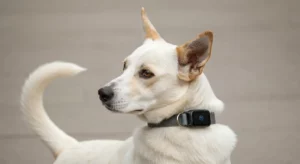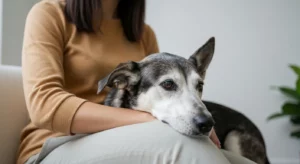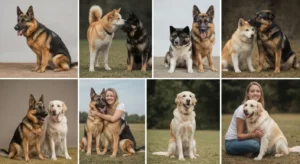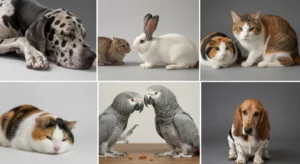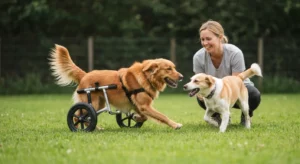As a Certified Applied Animal Behaviorist with over a decade of experience in both veterinary clinics and private consulting, I’ve seen firsthand how easily the signs of stress in pets can be missed or misinterpreted. We love our animals deeply, but because they can’t use words to tell us they’re overwhelmed, we have to learn to speak their language. And that language is behavior.
Chronic, unmanaged stress is more than just a bad day; it can lead to serious behavioral problems and even impact your pet’s physical health. The key to helping them is recognizing the subtle (and sometimes not-so-subtle) signals they send when they’re struggling. This isn’t about blaming you as an owner; it’s about empowering you to become your pet’s best advocate.
This comprehensive guide will walk you through ten of the most common signs of stress in pets. By understanding what to look for and what to do, you can transform your pet’s well-being and strengthen the incredible bond you share.
-
Sign #1: Changes in Body Language and Posture
The Sign: You notice your pet seems perpetually tense. For dogs, this might include a tucked tail, flattened ears, a lowered body posture, and showing the whites of their eyes (known as “whale eye”). For cats, stress often manifests as a crouched position with their head low, ears angled back or to the sides, and wide, dilated pupils even in bright light.
The ‘Why’: Body language is your pet’s primary form of communication. These postures are often involuntary responses to the activation of the sympathetic nervous system—the “fight or flight” system. When a pet feels threatened or anxious, their body physically prepares to either confront the danger or escape it. A tense body, a tucked tail to protect their vulnerable underside, and wide eyes to take in more visual information are all classic indicators that your pet is experiencing internal distress.
The Actionable Advice:
1. Become a Student of Your Pet: Actively watch your pet in different situations. Take photos or short videos of them when they are relaxed versus when they seem uneasy. Comparing these will help you build a visual dictionary of their unique stress signals.
2. Identify the Trigger: When you see this tense body language, immediately assess the environment. Is a stranger approaching? Is another dog staring at them? Is there a loud, unfamiliar noise? Identifying the source of the stress is the first step.
3. Create Distance: The most immediate and effective action is to increase the distance between your pet and the stressor. This might mean crossing the street on a walk, asking a guest to give your cat space, or moving your pet to a quiet room. Never force an interaction when your pet is showing these signs; you are teaching them that you won’t listen to their pleas for help. -
Sign #2: Gastrointestinal (GI) Upset
The Sign: Your pet is suddenly experiencing bouts of diarrhea, constipation, vomiting, or a decreased appetite, and your veterinarian has ruled out an obvious illness or dietary indiscretion.
The ‘Why’: The gut-brain axis is a powerful, scientifically proven connection. Stress hormones, particularly cortisol, have a profound impact on the digestive system. High levels of cortisol can slow down digestion, alter the gut microbiome (the healthy bacteria), and increase inflammation in the intestinal lining. For some pets, this manifests as loose stools or vomiting. For others, the anxiety is so overwhelming that it completely suppresses their appetite. Think about how you might feel nauseous before a big presentation—it’s the same principle at work.
The Actionable Advice:
1. First, See Your Veterinarian: This is non-negotiable. GI upset can be a sign of many serious medical conditions, from pancreatitis to intestinal parasites or blockages. You must rule these out before assuming the cause is purely behavioral.
2. Analyze Recent Changes: If your pet gets a clean bill of health, consider recent changes in their routine. Did you move? Is there construction happening next door? Did a family member leave for college? Pets thrive on predictability, and major disruptions are a common source of stress.
3. Support Gut Health: Talk to your vet about adding a pet-specific probiotic to support a healthy gut microbiome. For mild, situational stress (like before a car ride), they may also suggest calming supplements containing ingredients like L-theanine or tryptophan. Ensure fresh water is always available, especially if they have diarrhea, to prevent dehydration. -
Sign #3: Excessive Grooming, Licking, or Chewing
The Sign: Your dog is constantly licking their paws, or your cat is grooming the same spot on their belly or flank so much that the fur is thinning or gone (a condition known as psychogenic alopecia).
The ‘Why’: Grooming is a natural, comforting behavior. The repetitive motion can release endorphins, helping a pet to self-soothe when they feel anxious or conflicted. However, when this behavior becomes excessive, it’s no longer a healthy coping mechanism. It has become a compulsive habit, much like how a person might bite their nails to the quick when stressed. The pet is “stuck” in a behavioral loop, trying to calm an internal state of anxiety that never fully resolves.
The Actionable Advice:
1. Rule Out Medical Causes: Again, a vet visit is your first stop. The number one cause of excessive licking and chewing is allergies (environmental or food-related). Skin infections, parasites like fleas, or underlying pain in a joint can also be the culprit. Stress can exacerbate these conditions, but you need to treat the underlying medical issue first.
2. Increase Enrichment: A bored, under-stimulated mind is an anxious mind. Redirect that oral fixation onto appropriate outlets. Provide puzzle feeders instead of food bowls, introduce sturdy chew toys for your dog, and engage your cat with interactive wand toys. A “sniffari” walk, where your dog is allowed to sniff as much as they want, is fantastic mental exercise.
3. Interrupt and Redirect: When you see the obsessive licking start, calmly interrupt your pet by calling their name or making a gentle sound. As soon as they look up, ask them to do a simple behavior they know (like “sit”) and reward them, or offer them a puzzle toy. This breaks the cycle and gives them something else to focus on. -
Sign #4: Hiding or Social Withdrawal
The Sign: Your normally social cat now spends all day under the bed, or your dog, who used to greet you at the door, now retreats to their crate when you have guests over.
The ‘Why’: Hiding is a primary survival strategy. For a stressed pet, the world can feel overwhelming and dangerous. By retreating to a small, dark, enclosed space, they are attempting to reduce sensory input and remove themselves from perceived threats. This is not your pet being “antisocial” or “sullen”; it is a clear sign that they feel unsafe and are trying to cope in the only way they know how.
The Actionable Advice:
1. Respect the Safe Space: Never, ever pull your pet out of their hiding spot. This violates their trust and removes their only sense of security. Instead, make their chosen spot even safer. Put a comfy bed, a favorite blanket, and a bowl of fresh water nearby. For cats, a Feliway diffuser near the area can also help create a sense of calm.
2. Be a Detective: What changed in the home environment? A new baby? A new roommate? A new piece of furniture that makes strange noises? Even seemingly small things, like rearranging the living room, can be stressful for sensitive pets.
3. Build Positive Associations: From a distance, periodically toss high-value treats (like small pieces of chicken) toward their hiding spot without making eye contact or trying to lure them out. This teaches them that good things happen even when they feel the need to hide. Over time, this can help them feel more confident about re-engaging with their environment. -
Sign #5: Increased Vocalization
The Sign: Your cat is meowing or yowling incessantly, especially at night. Your dog is barking, whining, or whimpering more than usual, often without an obvious trigger.
The ‘Why’: Vocalization is a direct attempt to communicate an unmet need or an emotional state. A stressed pet may vocalize to get your attention because they feel insecure and need reassurance. They might be trying to alert you to a perceived threat (like the mail carrier they see every day but still find stressful). In cases of separation anxiety, barking or howling is a distress call. It’s not done to annoy you; it’s a cry for help.
The Actionable Advice:
1. Don’t Punish the Noise: Yelling at a barking dog or a meowing cat only adds more stress and anxiety to the situation. You might suppress the noise in the short term, but you haven’t addressed the underlying emotion, which will likely pop up in another, potentially worse, behavior.
2. Assess the Context: When does the vocalization happen? If it’s only when you’re preparing to leave the house, it points to separation anxiety. If it’s when someone walks past the window, it’s likely territorial stress. If your cat yowls at night, it could be cognitive dysfunction in an older cat or a need for more playtime during the day.
3. Meet the Underlying Need: If the cause is boredom, provide more exercise and enrichment. If it’s separation anxiety, consult a certified professional for a desensitization protocol. For territorial barking, use window film to block the view and work on counter-conditioning exercises. -
Sign #6: Destructive Behavior
The Sign: You come home to find your couch cushions shredded, your door frames chewed, or your favorite shoes destroyed. Your cat has started scratching the furniture instead of their scratching post.
The ‘Why’: Destructive behavior is not an act of “revenge” or “spite.” It is nearly always a symptom of a deeper issue, most commonly boredom, frustration, or separation anxiety. Chewing and scratching are natural, stress-relieving behaviors. When a pet doesn’t have an appropriate outlet for this energy and anxiety, they will turn to whatever is available—your sofa, your walls, your belongings. It’s a physical release for overwhelming internal turmoil.
The Actionable Advice:
1. Manage the Environment: This is your first line of defense. If you can’t supervise your pet, they should be in a pet-proofed area or a comfortable, enrichment-filled crate or pen. Don’t leave them with free roam of the house and opportunities to make mistakes. Put shoes away, use cord protectors, and provide multiple, appealing scratching posts for your cat right next to the furniture they target.
2. Amp Up the Exercise: A tired pet is a happy pet. Ensure your dog is getting enough physical exercise (walks, fetch, running) AND mental stimulation (training sessions, puzzle toys). For cats, 10-15 minutes of interactive wand toy play twice a day can make a world of difference.
3. Rule Out Separation Anxiety: If the destruction only happens when you are gone, it is very likely separation anxiety. This is a clinical panic disorder and requires a comprehensive behavior modification plan, often best implemented with the guidance of a veterinary behaviorist or certified separation anxiety trainer. -
Sign #7: Restlessness or Inability to Settle
The Sign: Your pet just can’t seem to relax. They are constantly pacing, getting up and lying down in different spots, whining, and seeking your attention. They seem unable to just switch off.
The ‘Why’: This is a state of hypervigilance. The pet’s nervous system is flooded with stress hormones, keeping them on high alert. They are physically unable to enter a relaxed state because their body and brain are telling them they need to be ready for danger. This can be caused by environmental stressors (e.g., unpredictable noises), underlying pain that prevents them from getting comfortable, or generalized anxiety.
The Actionable Advice:
1. Check for Pain: Restlessness is a major sign of pain, especially in senior pets with arthritis. If your pet can’t get comfortable, it may be because lying down hurts. A thorough vet check is essential.
2. Enforce a Predictable Routine: Pets feel safest when they know what to expect. Feed them, walk them, and play with them at roughly the same times each day. A predictable schedule helps lower ambient stress levels.
3. Practice “Calm Settle” Exercises: Reward your pet for doing nothing. When you catch them lying down calmly, even for a second, drop a small, tasty treat between their paws. This teaches them that being calm is a rewarding behavior. You can also use a specific “calm mat” and reward them for going to it and relaxing. -
Sign #8: Inappropriate Urination or Defecation
The Sign: Your perfectly house-trained dog has started urinating inside. Your cat, who has never missed the litter box, is now peeing on your bed, on rugs, or in your laundry basket.
The ‘Why’: This is one of the most serious and misunderstood signs of stress in pets. There are two primary reasons for this. First, stress can cause very real medical issues like Feline Idiopathic Cystitis (FIC), where the bladder becomes inflamed without an infection, making urination painful and urgent. Second, it can be a behavioral response called marking. Urine marking is a way for a pet to surround themselves with their own scent to feel more secure in an environment they perceive as threatening or to signal their presence to other animals.
The Actionable Advice:
1. IMMEDIATE Veterinarian Visit: I cannot stress this enough. This is a medical emergency until proven otherwise. Urinary blockages, especially in male cats, can be fatal within 24-48 hours. Urinary tract infections (UTIs), bladder stones, and kidney disease must be ruled out immediately.
2. Assess the Litter Box Situation: For cats, the rule of thumb is one litter box per cat, plus one extra (N+1). Boxes should be in quiet, low-traffic areas where the cat won’t feel cornered. They must be kept impeccably clean. If you changed litter types recently, that could be the trigger.
3. Clean Thoroughly and Identify Stressors: Clean any soiled areas with a high-quality enzymatic cleaner (not an ammonia-based one) to completely eliminate the odor that attracts them back to the spot. Then, look for stressors. Is another pet bullying them away from the litter box? Is there a new stray cat outside triggering territorial anxiety? -
Sign #9: Yawning, Lip Licking, and “Shaking Off”
The Sign: You notice your pet yawning when they aren’t tired, licking their lips when there’s no food around, or doing a full-body “shake off” as if they were wet when they are perfectly dry.
The ‘Why’: These are what behaviorists call “displacement behaviors” or “calming signals.” When a pet is in a mildly stressful or socially awkward situation, they will perform a seemingly out-of-context behavior to dissipate their nervous energy. A dog might yawn when a child hugs them too tightly, not because they are sleepy, but to signal their discomfort. A lip lick can indicate anxiety about an approaching person. A “shake off” after a tense interaction with another dog is a literal, physical way to release the built-up tension from the encounter.
The Actionable Advice:
1. Pay Attention to Context: The key to interpreting these signals is the context. A yawn after a nap is just a yawn. A yawn while a stranger is petting them is a stress signal. Start noticing when these behaviors occur.
2. Heed the Warning: These signals are your pet’s polite way of saying, “I’m not comfortable with this.” They are an early warning sign that precedes more overt signals like growling or snapping. When you see them, it’s your cue to intervene.
3. Advocate for Your Pet: If your dog yawns and licks their lips when your guest leans over them, politely ask the guest to give them some space. Say, “He’s a little shy, let’s let him come to you.” By responding to these subtle cues, you are showing your pet that you understand and will protect them, which builds immense trust. -
Sign #10: New or Increased Aggression
The Sign: Your previously friendly pet is now growling, snarling, snapping, hissing, or lunging at people or other animals. This behavior seems to have come out of nowhere.
The ‘Why’: Aggression is the sign of stress that scares owners the most, but it’s crucial to understand that it is almost always rooted in fear. It is a distance-increasing behavior. The pet feels threatened and believes that this is the only way to make the scary thing go away. It is a last resort, often used when all the more subtle signals (like those listed above) have been ignored or have failed. A sudden onset of aggression can also be a strong indicator of underlying pain or a medical condition (like a neurological issue or hypothyroidism in dogs).
The Actionable Advice:
1. Do NOT Punish the Growl: A growl is a warning. It is your pet’s communication that they are extremely uncomfortable and are close to their breaking point. If you punish the growl, you don’t remove the fear; you just teach your pet not to give a warning before they bite. This is incredibly dangerous.
2. Consult a Professional Immediately: This is not a “wait and see” situation. First, schedule a complete veterinary exam to rule out pain or medical causes. Then, find a certified professional—a veterinary behaviorist (DACVB), a Certified Applied Animal Behaviorist (CAAB), or a certified dog trainer who specializes in aggression and uses positive reinforcement methods (look for credentials like KPA, CPDT-KA, or IAABC).
3. Manage and Prevent: While you are waiting for professional help, your job is to manage the environment to prevent the aggressive behavior from being rehearsed. This might mean keeping your dog on a leash, using baby gates to create separate zones in the house, avoiding the dog park, or keeping your cat in a separate room when guests are over. Safety for everyone involved is the top priority.
Recognizing the signs of stress in pets is the first and most critical step toward helping them live happier, healthier lives. Your pet is constantly communicating with you. By learning to interpret their behavior, you move beyond just being their owner and become their trusted guardian and advocate.
If you see several of these signs, or if a single sign is severe or persistent, please don’t hesitate to seek professional help. A consultation with your veterinarian and a qualified behavior professional is one of the most valuable investments you can make in your pet’s long-term well-being.




